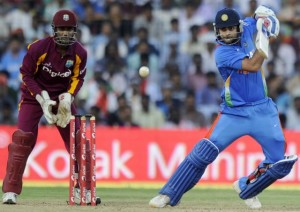By: St. Clair Sazam Hull
Nevispages.com
The success of Twenty20 cricket around the world is accompanied by concern about the future of Test and ODI cricket. Some of us have already signed a death warrant on these two more traditional forms of the game, which is obviously a hasty and dramatic conclusion. Cricket is actually at a very interesting stage in its evolution and it’s too early to say where this game will be in 20 years time, what we see today are only trends.
One sight that shook me this year was that of a half-full stadium at Warner Park in St. Kitts, when West Indies took on Bangladesh in an official ODI. One month prior to that in August, the same stadium was packed to capacity for the Caribbean Premiere League.

Going forward I think it is 50-overs cricket not Test that is vulnerable and is more likely to suffer. The prime reason being that Test cricket is so completely different from T20 cricket that it will never be in competition with it. That will remain Test cricket’s great strength. T20 is the new faster-paced version of 50-overs cricket, like a processor in a computer, which mostly does the same things but quicker. As I said earlier recognizing trends is imperative. The need for constant tweaking of one-day rules is telling us something about one-day cricket. In today’s world it is not exciting the masses as much as it used to. T20 seems to have whetted the appetite of the masses.
It would be a huge mistake to assume that the success of the last World Cup was a success of 50-overs cricket. That tournament was a hit because it was a World Cup where nearly every match had relevance, unlike with most ODIs held every year. Also, the fact that many of the games were played in India added to the thrill and festivity. India doing well and reaching the final, also assured a large fan following for the event right through.
Outside of that I have had a problem with one-day cricket for a while now. Like its name suggests, it is cricket with limits, a format that never fully extends itself. A number of cricketers with limited talents, bits and pieces of cricketers, in-betweeners, neither very good batsmen nor very good bowlers made long careers out of it. Neither this nor that, that is what 50-overs cricket is now and that is its big weakness, which makes it the most dispensable form of the game today.
One-day cricket did some real good when it arrived on the scene, but we don’t realize how much damage it has also done to cricket as we knew it. I remember Winston Benjamin once telling me at a youth tournament in Antigua how one-day cricket almost killed his outswinger. Winston said he was forced to bowl a lot straighter than he normally would just to be economical in ODIs and also to ensure he wasn’t wided by the umpire every time that beautiful outswinger swung a little bit more than intended.
Bowlers in one-day cricket stopped thinking in terms of taking wickets long ago and started thinking instead of runs being scored. Bowlers in ODIs became like men pulling out water pistols in a wild-west gunfight. Think of how much harm this basic change in mindset has done to the sport as a spectacle. For a large chunk of a 50-overs inning from the 15th to the 40th we have a situation where a batting team is happy to get four runs per over and the opposition is happy to concede them. Where is the contest? Fifty-over cricket has also ensured the flattening-out of pitches giving rise to a breed of successful attacking batsmen who hit through the line without moving their feet.
Take a hard critical look at it and you will see that ODI cricket has slowly but surely help rid the game of pace, swing, spin and harmed the techniques of batsmen and bowlers and negatively affected the basic skills that made the game worth watching. All this is not to say T20 is not also a limited-overs format, which shares some of the ills of ODI cricket. It is, but it does not limit itself as 50-overs cricket does. It takes certain cricketing skills to the extreme-attacking batting, for instance, it also pushes the bowlers to the edge, compelling them to dig deep and bring out all their skills to survive in response to extreme threat.
It’s no surprise that we often see some really hostile spells in T20 cricket from genuine fast bowlers. This is an attacking response, made possible because the fast bowler knows he is not going to be bowling more than four overs a day and often just two overs in a spell. So he does not tend to hold back. The same can be said about fielding too.
Learning from the damage done by one-dayers, if the number of T20s is kept down and matches are made more relevant, T20 cricket can do no worse than ODI cricket. Furthermore, its appeal is far greater and its financial benefits more far-reaching. I do believe that the time has come for administrators to stop expending their energies on bringing back life into one-day cricket. There is only so much you can do with basic concept. The market too has spoken against one-dayers because sponsors are not excited about them unless it’s a World Cup competition.
The time is now then to re-think if ODI cricket is still viable.
